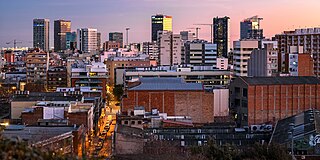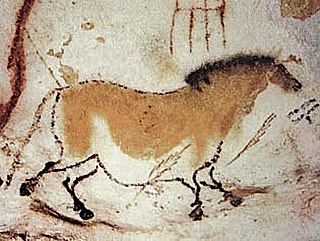
The Palau Reial Major is a complex of historic buildings located in Plaça del Rei, Barcelona, Catalonia, Spain. It was a residence of the counts of Barcelona and later, of the Kings of Aragon. It is composed of three distinct edifices:
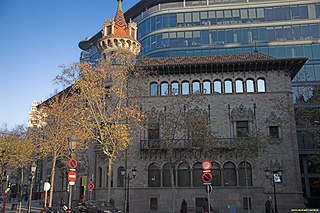
The Barcelona Provincial Council Local Museum Network, also known as Catalonia’s Biggest Museum, is a tool for support and collaboration from and for the museums of the province, which makes available to municipalities a series of services and actions aimed at improving, through the provision of direct services and research into viable formulas for supramunicipal cooperation, the management, conservation and dissemination of heritage and the museum facilities of the towns of Barcelona province. It is managed from the Cultural Heritage Office, which in turn depends on the Department of Knowledge and New Technologies of Barcelona Provincial Council.
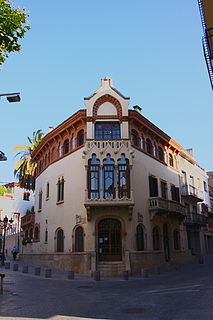
The Lluís Domènech i Montaner House-Museum, in Canet de Mar, in the region of El Maresme, is a space dedicated to the study of the life and works of architect Lluís Domènech i Montaner. The House-Museum includes the Domènech house, a work of the architect in collaboration with his son, Pere Domènech and his son-in-law, Francesc Guàrdia, and the 16th-century Can Rocosa farmhouse, which Domènech i Montaner converted into his workshop-study. The House-Museum is part of the Barcelona Provincial Council Local Museum Network.

The Cardadeu Tomàs Balvey Museum-Archive, in Cardedeu, Vallès Oriental, is organised around the legacy of Tomàs Balvey i Bas (1865–1954), the last of a line of apothecaries in Cardedeu. The theme of the museum is based on the pharmacy and its pharmacist, focusing on the world of illness, remedies and health. The Museum-Archive is part of the Barcelona Provincial Council Local Museum Network and of the Catalan Pharmacy Museum Network.

The Can Tinturé Museum, in Esplugues de Llobregat, is located in a house built at the end of the 19th century by architect Claudi Duran i Ventosa, and is the first monographic sample tile museum in Spain. The Can Tinturé Museum also manages the museum at the Pujol i Bausis factory, La Rajoleta, which was a point of reference in the production of Catalan industrial tiles, especially during the highpoint of Art Nouveau. The Museum is part of the Barcelona Provincial Council Local Museum Network and of the territorial system of the Science and Technology Museum of Catalonia.

The Granollers Museum is a heterogeneous collection comprising archaeology, decorative arts, ethnography, numismatics and ancient, modern and contemporary art. The Museum, which is part of the Barcelona Provincial Council Local Museum Network, coordinates and supports a major part of the archaeological excavations taking place in the region of El Vallès Oriental, while promoting awareness and protection of local cultural heritage. In addition, the Museum manages L'Adoberia, the medieval Granollers historic interpretation centre.
The L’Enrajolada Santacana House-Museum (, in Martorell, is one of the oldest museums in Catalonia. It was founded in 1876 by Francesc Santacana i Campmany and then taken over by his grandson, Francesc Santacana i Romeu. It is located in an old private residence with four floors and a garden, which belonged to the Santacana family. L'Enrajolada is part of the Barcelona Provincial Council Local Museum Network.
The Vicenç Ros Municipal Museum, in Martorell, occupies one of the sections of an old Capuchin convent dating back to the 17th century and is part of Barcelona Provincial Council Local Museum Network. Opened in 1945, the museum came to be thanks to Vicenç Ros i Batllevell (1883–1970), who donated his large ceramics collection. Over the years, the museum has organised its collection into different categories, which it has expanded: ethnology, art, archaeology, architecture and archives.

The El Masnou Municipal Nautical Museum is a municipally owned museum, the backbone of which is El Masnou’s relationship with the sea. It is part of the Barcelona Provincial Council Local Museum Network, the Maritime Museums of the Catalan Coast Network and the Mediterranean Maritime Museum Association.

The Mataró Museum is a museum in Mataró, in El Maresme, with a central office in Can Serra, a fortified Renaissance building dating back to 1565. The Museum, which is part of the Barcelona Provincial Council Local Museum Network, also manages the different local heritage centres, such as:
The aim of the Montcada Municipal Museum, founded in 1982 and housed in the old Casa de la Vila de Montcada i Reixac since 1987, aims to recover, conserve and protect local heritage. Among its collection, it is worth mentioning the findings from the Iberian settlement of Les Maleses, in the Serralada de Marina Natural Park. The museum also has a permanent exhibition divided into five areas: the environment, mineralogy and palaeontology; prehistory; the Iberian world; medieval and modern Montcada; and, finally, contemporary Montcada. The Museum is part of the Barcelona Provincial Council Local Museum Network.
The El Prat Museum, in El Prat de Llobregat, was created in 1962 as part of an initiative of the town council to recover the town’s historic and natural heritage. It is located in Balcells Tower, a building from the mid-19th century that was used for farming and as a summer residence, and is part of the Barcelona Provincial Council Local Museum Network. In the next few years the El Prat Museum will relocate to a new building currently under construction.
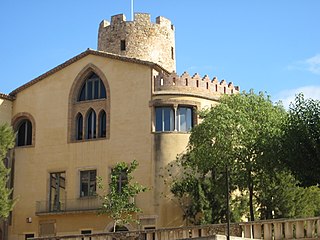
The Balldovina Tower Museum of Santa Coloma de Gramenet in Catalonia, Spain, is a local pluridisciplinary museum, the aim of which is to protect, conserve, study and disseminate the cultural and natural heritage of the territory. The museum, which is part of the Barcelona Provincial Council Local Museum Network, looks after its own collections as well as the monumental heritage of the town of Santa Coloma.

The Maricel Museum is a museum located in the centre of Sitges; reopened after a major refurbishment in 2015.

The Textile Museum and Documentation Centre is a museum institution located in Terrassa, a city with an important textile tradition. Managed by a consortium consisting of Terrassa Town Council and Diputació de Barcelona, it presents a panoramic view of the different styles and techniques used all over the world in fabric making throughout history. It is part of the Barcelona Provincial Council Local Museum Network.
The Terrassa Museum is a museum entity which encompasses all the municipally owned museums in the city of Terrassa. It belongs to the History Museum and Monument Network of Catalonia and the Barcelona Provincial Council Local Museum Network.

The purpose of the Vilassar de Dalt Archive-Museum is the conservation and dissemination of the archaeological, architectural, historical, natural and cultural heritage of Vilassar de Dalt and its environment. Located in the Can Banús farmhouse, records for which date back as far as the 14th century, its main collection can be broken down into four categories: archaeology, textiles, history and the historic archive.
The Vilassar de Mar Municipal Museum is a local museum in Vilassar de Mar comprising two facilities: The Marina Museum, focusing on local history and placing special emphasis on its connection with the nautical world, and the Monjo Museum, which tells the story behind the legacy of Vilassar de Mar sculptor Enric Monjo.

The Barcelona City History Museum is a city museum that conserves, researches, communicates and exhibits the historical heritage of the city of Barcelona, from its origins in Roman times until the present day; it is funded by the Barcelona municipality. The museum's headquarters are located on Plaça del Rei, in the Barcelona Gothic Quarter. It also manages several historic sites all around the city, most of them archaeological sites displaying remains of the ancient Roman city, called Barcino in Latin. Some others date to medieval times, including the Jewish quarter and the medieval royal palace called the Palau Reial Major. The rest are contemporary, among them old industrial buildings and sites related to Antoni Gaudí and the Spanish Civil War. The museum was inaugurated on 14 April 1943; its principal promoter and first director was the historian Agustí Duran i Sanpere.

